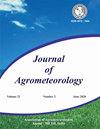印度旁遮普省巴辛达地区热浪和寒潮发生率评估及其与地表温度的联系
Q3 Agricultural and Biological Sciences
引用次数: 0
摘要
本研究调查了 2000 年至 2022 年旁遮普省西南部地区巴辛达县的热浪和寒潮发生情况。在 2002 年和 2022 年,热浪(HW)活动明显激增,分别达到 29 天和 27 天。同样,在严重热浪(SHW)方面,2010 年和 2022 年出现的频率最高,分别为 16 天和 18 天。相反,寒潮(CW)活动在 2005 年和 2008 年达到高峰,分别为 10 天和 11 天。值得注意的是,2008 年也出现了频率最高的强寒潮(SCW),达 15 天。然而,结果显示,寒潮日数在后几年有所减少,而强寒潮日数也呈现出频率下降的趋势,如 2015 年和 2016 年的寒潮日数和强寒潮日数均为零。一项重要发现强调了热浪期间陆地表面温度(LST)与最高气温之间的显著相关性(R2 = 0.83),表明陆地表面温度可作为热浪事件期间监测气温趋势的指标。本文章由计算机程序翻译,如有差异,请以英文原文为准。
Assessment of heat and cold wave incidences and their link with land surface temperature in Bathinda district of Punjab, India
This study investigates the incidence of heat wave and cold wave condition during 2000 – 2022 in the Bathinda district of South-Western region of Punjab. Notable spikes in heat wave (HW) activity were observed in 2002 and 2022 with 29 and 27 days respectively. Similarly, for severe heat waves (SHW), 2010 and 2022 witnessed the highest frequencies recording 16 and 18 days respectively. Conversely, cold wave (CW) events peaked in 2005 and 2008 with 10 and 11 days respectively. Notably, 2008 also observed the highest frequency of severe cold wave (SCW) days with 15 days. However, results revealed decline in cold wave days towards the latter years, while severe cold wave days also exhibited decreasing frequencies like 2015 and 2016 recorded zero CW and SCW days. One key finding highlights a substantial correlation between land surface temperature (LST) and maximum air temperature during heat wave periods (R2 = 0.83), indicating LST's efficacy as an indicator for monitoring temperature trends during heat wave events.
求助全文
通过发布文献求助,成功后即可免费获取论文全文。
去求助
来源期刊

Journal of Agrometeorology
农林科学-农艺学
CiteScore
1.40
自引率
0.00%
发文量
95
审稿时长
>12 weeks
期刊介绍:
The Journal of Agrometeorology (ISSN 0972-1665) , is a quarterly publication of Association of Agrometeorologists appearing in March, June, September and December. Since its beginning in 1999 till 2016, it was a half yearly publication appearing in June and December. In addition to regular issues, Association also brings out the special issues of the journal covering selected papers presented in seminar symposia organized by the Association.
 求助内容:
求助内容: 应助结果提醒方式:
应助结果提醒方式:


